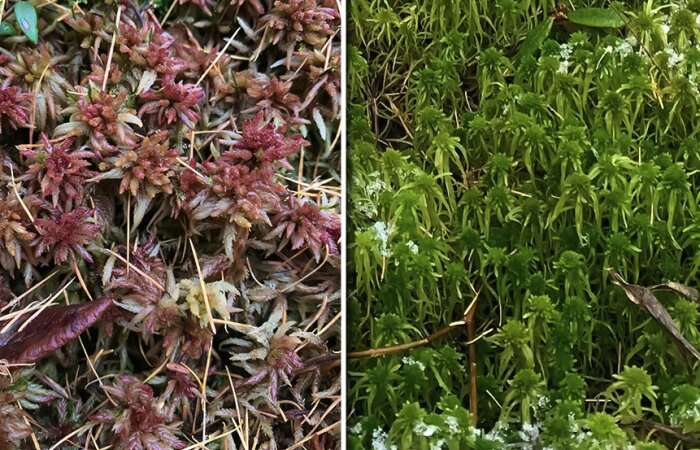This article has been reviewed according to Science X's editorial process and policies. Editors have highlighted the following attributes while ensuring the content's credibility:
fact-checked
peer-reviewed publication
trusted source
proofread
Scientists find sex differences in mosses play key role in carbon storage

A quest to understand how Sphagnum mosses facilitate the storage of vast amounts of carbon in peatlands led scientists to a surprising discovery: The plants have sex-based differences that appear to impact the carbon-storing process.
The insight can help researchers better understand how the mosses tolerate stressful environments, including those of a warming climate.
The research team co-led by the Department of Energy's Oak Ridge National Laboratory sequenced the genome of two key species of Sphagnum, the mossy plants that dominate peatlands and store about one-third of the world's soil carbon despite covering just 3%–5% of Earth's land surface. Sphagnum mosses are known as the chief engineer of long-term carbon storage in peat, helping keep the bogs wet, acidifying the environment and slowing down plant decay, which in turn retains carbon in the soil. Sphagnum, living and dead, likely store more carbon than any other genus of plant.
These unique, soggy peat bogs are under threat, however, from rising temperatures that could dry them and hamper their ability to absorb and retain carbon. In fact, research at the DOE Spruce and Peatland Responses Under Changing Environments, or SPRUCE, whole-ecosystem manipulation experiment in northern Minnesota has revealed that warming conditions result in peat bogs turning from carbon accumulators into carbon emitters.
To better comprehend the genetics at play in peat carbon cycling, scientists at ORNL teamed with researchers from the HudsonAlpha Institute for Biotechnology; the DOE Joint Genome Institute, or JGI, a DOE Office of Science user facility at Lawrence Berkeley National Laboratory; Duke University and others to sequence the complete genome of two Sphagnum species—S. divinum and S. angustifolium—present at the SPRUCE site. ORNL scientists also created a pedigree population of the mosses to link genes with Sphagnum traits.
The research revealed tiny chromosomes that determine whether the plant is male or female. Scientists also found that these sex-determining chromosomes interact with other chromosomes to regulate plant responses to stress. The result, as described in Nature Plants, is important not just to the mosses' survival, but to their role in accumulating and holding carbon over time.
"We know that the climate is changing, and it's changing rapidly at high latitudes," said Bryan Piatkowski, an evolutionary biologist and distinguished staff fellow at ORNL who began working on the project in 2018 at Duke. "Basically, the growth rate of these Sphagnum species is influenced by both plant genotype and the environment in a manner that depends on the sex of the plant."
The discovery could lead to scientific solutions to help Sphagnum survive a changing climate. "These genomes are coming from the plants that are largely responsible for storing carbon in these ecosystems," Piatkowski said. "Knowledge of their genetics can provide us with insights to help peatlands continue being the carbon sinks they have been for thousands of years, instead of net sources of greenhouse gases like carbon dioxide and methane as the climate warms."
"The presence of the sex chromosome together with interactions with non-sex chromosomes and environmental conditions influence the plant's ability to survive and adapt to harsh conditions," said Dave Weston, a molecular plant biologist who led ORNL's efforts. "Understanding those contributions to Sphagnum survival and reproduction will be super important in understanding how resilient this ecosystem is to changing climatic conditions, which cascades to their ability to sequester carbon for long-term storage."
The research is a good example of linking genes to ecosystem function and emphasizing the importance of ecological genomics in advancing biology questions, Weston said.
Piatkowski said the pedigree analysis on the moss species enables new insights into how Sphagnum relates to symbiotic microbes—how relationships with bacteria, for instance, might help plants survive under warmer scenarios in the future. "The genetic resources developed as part of this project are now allowing our team to investigate the benefits of the plant microbiome under stress at the molecular level. It's an exciting area of research not possible without these genomes."
The sequencing work and much of the comparative genomics and quantitative genetics was led by HudsonAlpha and JGI, while Duke focused on plant taxonomy, population genetics and plant collections. ORNL conducted the experimentation, performed analysis of the mosses' evolutionary history, collected plant material, performed nucleotide extractions for genome sequencing and developed the pedigree populations that enabled gene-to-trait linkages.
More information: Adam L. Healey et al, Newly identified sex chromosomes in the Sphagnum (peat moss) genome alter carbon sequestration and ecosystem dynamics, Nature Plants (2023). DOI: 10.1038/s41477-022-01333-5
Journal information: Nature Plants
Provided by Oak Ridge National Laboratory





















